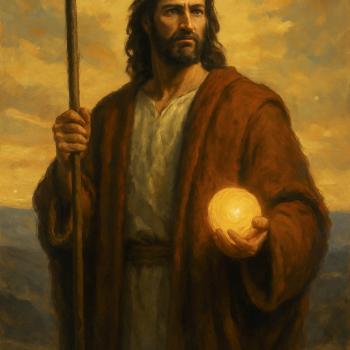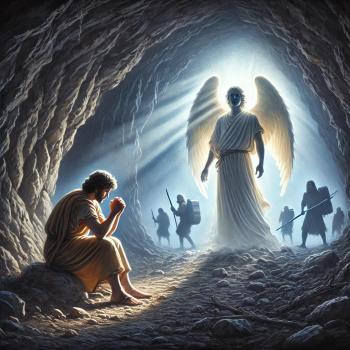Revelation 12:1-18 The Woman, Child, and Dragon
Seven Key Figures Part 1
Revelation 12:1-18 The Woman, Child, and Dragon is the first sermon in a three-part series of the “Seven Key Figures” of Revelation.
As well as being the start of a new major section, Revelation 12 stands as the theological heart of the book because it shows why the church faces spiritual hostility in this world and how God provides the victory. Revelation 12:1–14:20 forms a grand interlude detailing the cosmic conflict between God and the forces of evil, as well as God’s vindication of his people and judgment of the unrighteous. In 12:1–13:18 we hear about the battle between the false trinity (Satan, sea beast, and earth beast) and the Triune God and his people.
More specifically, chapter 12 consists of three scenes: the woman, the son, and the dragon (12:1–6), the war in heaven (12:7–12), and the war on earth (12:13–17). Believers have already learned that suffering will accompany their vocation as witnesses in this world (10:1–11:13). Now, they come to understand more about the spiritual war they are fighting. Sometimes gaining a larger perspective on our spiritual conflict can inspire faithful endurance.1
Today, we will look at the three main characters in this chapter: the woman, the child, and the dragon.
1. The Woman (Revelation 12:1-2)
“A great sign appeared in heaven: a woman clothed with the sun, with the moon under her feet and a crown of 12 stars on her head. She was pregnant and cried out in labor and agony as she was about to give birth.” (Revelation 12:1–2, HCSB)
Is the woman Mary?
The first figure is a woman. The woman was clothed with the sun and the moon and twelves stars. She became pregnant and gave birth. Some may think that the woman is Mary. If you look at only at the immediate context, that would be true:
“But she gave birth to a Son—a male who is going to shepherd all nations with an iron scepter —and her child was caught up to God and to His throne.” (Revelation 12:5, HCSB)
The Woman is the nation of Israel
Yet, in the next verse, the same woman is sent into the desert.
“The woman fled into the wilderness, where she had a place prepared by God, to be fed there for 1,260 days.” (Revelation 12:6, HCSB)
So how can the woman give birth and then flee for 1260 days? It must mean that the woman represents the same person in two different time periods. In the first, she is the people of God before the coming of Christ. The symbolism of the sun, moon, and stars relates to a prophecy in Genesis. As Craig Keener notes:
The sun, moon, and twelve stars on the woman confirm this vision as symbolizing Israel or its faithful remnant (Genesis 37:9).23
“Then I heard the man dressed in linen, who was above the waters of the river. He raised both his hands toward heaven and swore by Him who lives eternally that it would be for a time, times, and half a time. When the power of the holy people is shattered, all these things will be completed.” (Daniel 12:7, HCSB)
Here, the angel tells us that the holy people will be shattered and things will be completed. The time is 1290 days.
“From the time the daily sacrifice is abolished and the abomination of desolation is set up, there will be 1,290 days.” (Daniel 12:11, HCSB)
Paige Patterson gives one more reasons to believe that the woman is Israel:
The idea that the radiant woman is the church must be dismissed as even less plausible. Christ gives birth to the church; the church does not give birth to the Lord. Nowhere is the church presented in such pageantry, and some of the same objections to identifying the radiant woman with Mary are also applicable to the idea that this radiant woman is the church.4
The point to this picture is that woman is not literal. The woman represents the people who bring about the child. The woman is Israel. Next, we meet the Son, also known as the male child.
2. The Male Child (Revelation 12:4-5)
“His tail swept away a third of the stars in heaven and hurled them to the earth. And the dragon stood in front of the woman who was about to give birth, so that when she did give birth he might devour her child. But she gave birth to a Son—a male who is going to shepherd all nations with an iron scepter —and her child was caught up to God and to His throne.” (Revelation 12:4–5, HCSB)
The scene actually describes the dragon first, but I want to move to the male child because that is the natural result of the childbirth. The dragon is in conflict with the male child. The child is Jesus because is the Son, and it describes how He will rule. This comes from the prophecy of Jacob about Jesus ruling from Israel. The verse in Revelation 12 states that he will still rule, which implies a future reign. Jesus came to serve, to save, and we are still waiting for Him to rule. He will soon do this, but not before one last confrontation with Jesus.
3. The Dragon
“Then another sign appeared in heaven: There was a great fiery red dragon having seven heads and 10 horns, and on his heads were seven diadems.” (Revelation 12:3, HCSB)
Revelation shows the dragon as someone who is in conflict with both the mother and the child. Here, I will show that Revelation tells us who the dragon represents as well as characteristics of that dragon.
SEVEN CHARACTERISTICS OF SATAN IN REVELATION 12
1. He has political influence (Revelation 12:3)
The dragon is someone who has power over ten countries and seven people. We address that political influence in Revelation 13 with the Antichrist.
2. He is rebellious to God’s authority (Revelation 12:4)
The dragon is the same who has an insurrection. He tries to oppose God in Heaven and is thrown to Earth.
“His tail swept away a third of the stars in heaven and hurled them to the earth…” (Revelation 12:4, HCSB)
3. He opposes God’s plan (Revelation 12:4)
“…And the dragon stood in front of the woman who was about to give birth, so that when she did give birth he might devour her child.” (Revelation 12:4, HCSB)
After his insurrection, Satan tried to stop the plan of God in various ways. He used Herod to try to kill all of the male babies in order to stop God’s plan. He tempted Jesus, tempted Judas to give up Jesus,a and tempted the people of God to kill the Son of God.
4. He fails to stop God’s Son (Revelation 12:5)
His attempt failed. In one short verse, we see the description of entire life of Jesus on Earth. Satan tempted Jesus, tempted Judas to give up Jesus, and tempted the people of God to kill the Son of God.
“But she gave birth to a Son—a male who is going to shepherd all nations with an iron scepter —and her child was caught up to God and to His throne.” (Revelation 12:5, HCSB)
This represents Satan’s attempt to usurp God’s kingdom. He tried to influence angels to stop God in Heaven. Then He influenced people to try to stop Jesus on Earth. Both attempts failed.
5. He will fail in his future attempt to stop Israel (Revelation 12:6-8)
“The woman fled into the wilderness, where she had a place prepared by God, to be fed there for 1,260 days.” (Revelation 12:6, HCSB)
Satan will attempt to stop Israel. We now know that God resurrected Israel for a future purpose. Satan will try to stop Israel. God will again intervene and prevent Satan from destroying God’s people.
“Then war broke out in heaven: Michael and his angels fought against the dragon. The dragon and his angels also fought,” (Revelation 12:7, HCSB)
Michael, who I believe is the guardian archangel assigned to Israel will intervene. There will be angelic war over Israel, at the same time that there will be an earthly, politically-based, military campaign against Israel. While Israel is attacked, God will move to protect His people. Satan will go to attack Israel’s angelic army of protectors.Yet, he will fail.
6. He will fail in his future attempt to overthrow God’s divine protective actions (Revelation 12:8-9, Revelation 12:13-18)
“but he could not prevail, and there was no place for them in heaven any longer. So the great dragon was thrown out—the ancient serpent, who is called the Devil and Satan, the one who deceives the whole world. He was thrown to earth, and his angels with him.” (Revelation 12:8–9, HCSB)
This represents Satan’s overthrow in the future. He is the god of this world. In the past, he had access to Heaven. At this point, he will be denied that access.
When the devil is denied access, he will go after Israel. The time of this intense persecution will be 3 ½ years. God will supernaturally protect His people for this same time period. Satan will try to stop God’s people in two separate campaigns.
CAMPAIGN AGAINST ISRAEL (Revelation 12:13-16)
When the devil is denied access, he will go after Israel. The time of this intense persecution will be 3 ½ years. God will supernaturally protect His people for this same time period.
“The woman was given two wings of a great eagle, so that she could fly from the serpent’s presence to her place in the wilderness, where she was fed for a time, times, and half a time.” (Revelation 12:14, HCSB)
In this campaign, Satan will make political and military strikes to stop the nation of Israel. The people of Israel will be flown to a secure place (possibly Egypt). Although Satan will use his political abilities to stop her (including flooding her out with water), Israel will be protected for 3 ½ years.
CAMPAIGN AGAINST CHRISTIANS (Revelation 12:17-18)
In this campaign, which follows immediately after the campaign against Israel, Satan will try to stop Christians. I believe we will see the details of that campaign in Revelation 13.
7. His future end will come about by the sharing of the Gospel (Revelation 12:10-12)
“Then I heard a loud voice in heaven say: The salvation and the power and the kingdom of our God and the authority of His Messiah have now come, because the accuser of our brothers has been thrown out: the one who accuses them before our God day and night.” (Revelation 12:10, HCSB)
Sandwiched between Satan’s attempt to stop Israel, is a section about Satan’s attempt to stop Christians. Yet, He will reek havoc on the Earth since he will be locked out from Heaven. Harming him will be difficult, but possible. The only way to overcome Satan will be in proclaiming the Gospel.
“They conquered him by the blood of the Lamb and by the word of their testimony, for they did not love their lives in the face of death.” (Revelation 12:11, HCSB)
The time of this persecution will be short:
“Therefore rejoice, you heavens, and you who dwell in them! Woe to the earth and the sea, for the Devil has come down to you with great fury, because he knows he has a short time.” (Revelation 12:12, HCSB)
Revelation 12 lays out a cosmic hero’s journey. In his book, A Hero With a Thousand Faces, Joseph Campbell explains how all great movies have a similar arc – the hero’s journey. At the same time, Revelation 12 shares a very similar journey. Robert Wall shares the essentials of the mythic story that appears here in Revelation in the following way:
The essential features of this mythic story are as follows: at the birth of a promised ruler, an evil pretender to his throne attempts to reverse the wishes of the gods by killing the ruler at birth. The infant ruler, however, escapes and eventually kills his persistent and life-long enemy, ending his reign of terror in accord with the interests of the gods.
By re-presenting the essential features of Jesus’ messianic career as mythic, John allows the myth’s interpretation of life to re-interpret the Christ event of the Christian gospel: even though the promised Messiah was born into conflict, he eventually triumphed, thus securing God’s salvation for God’s people. In fact, by extending the traditional myth to include the triumphant child’s ascension into heaven (12:5b) and the Evil One’s subsequent banishment from heaven to fallen earth (12:7–9), John underscores the primary importance of Christ over the “Caesars” of any age.5
This summary of the complete cosmic battle in Revelation is the story that we must continue to share.
1 J. Scott Duvall, Revelation, ed. Mark L. Strauss and John H. Walton, Teach the Text Commentary Series (Grand Rapids, MI: Baker Books, 2014), 160.
2 Such cosmological imagery appears elsewhere for the patriarchs (T. Abr. 7A; 7B; T. Naph. 5:3–5).
3 Craig S. Keener, Revelation, The NIV Application Commentary (Grand Rapids, MI: Zondervan Publishing House, 1999), 314.
4 Paige Patterson, Revelation, ed. E. Ray Clendenen, vol. 39, The New American Commentary (Nashville, TN: B&H, 2012), 261.
5 Robert W. Wall, Revelation, Understanding the Bible Commentary Series (Grand Rapids, MI: Baker Books, 2011), 158–159.













